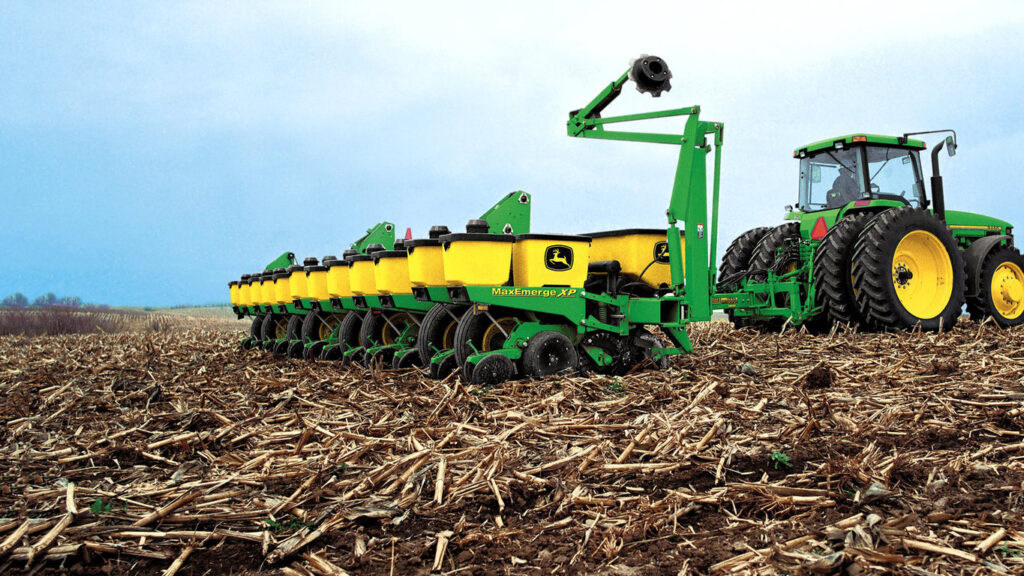
John Deere 1775 Flex Drawn Planter
Agriculture
- 12 rows on 30-in. spacing
- Available in 1.6-bu. or 3-bu. MaxEmerge™ 5 row unit
- Insecticide option for 1.6-bu.
- 2-section frame flexes 20 degrees up & 30 degrees down
Featured List
- Central Commodity System (CCS): N/A
- Number of Rows: 12
- Spacing (inches): 30
- Row Unit: MaxEmerge 5
- Transport Width: 15 ft. 2 in.
Featured Content
Seed variable-rate drive provides the ultimate planting productivity by utilizing one, two, or three hydraulic motors (varies by model) to turn the seeding drive shaft. Hydraulic control of the seeding drive allows for on-the-go seeding rate changes right from the display mounted inside the tractor cab. Combine this seeding flexibility with the map-based planting option, and seeding rates adjust automatically based on the prescribed map.
Variable-rate drive offers the following advantages over common, ground, or contact-tire drive systems:
-
Rate changes are almost instantaneous; no ramp up or ramp down of system as in some competitive systems - Permits the producer to match seed population based on different soil types or irrigation practices
- John Deere design provides added operator safety by eliminating any possible drive creep found in some competitive variable-rate drive systems
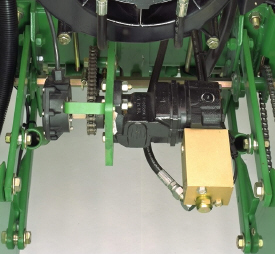
1755 equipped with variable-rate drive
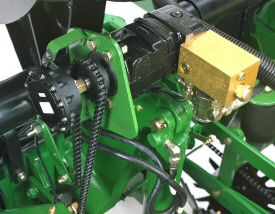
1765NT equipped with variable-rate drive
Single- or dual-motor systems for variable-rate drives are available for all John Deere planters except the 1785 Rigid Frame. Variable-rate drive is available as a factory-installed option for all applicable planter models.
Single- or dual-motor systems are available as field-installed attachments for most planter models; however, a three-motor variable-rate drive field-installed attachment is not available.
Seed variable-rate drive requires the SeedStar™ monitor and a radar input signal. Either tractor or planter radar may be used. Planter radar is ordered separately.
NOTE: Peanut seed meter disks require the variable-drive transmission.
Crop yields have increased through the years along with the amount of residue left in the field after harvest. At the same time, tillage practices have changed, including different tillage operations which maintain large amounts of surface residue, and even no-till practices. Row cleaners are an essential tool in managing this increased amount of residue.
John Deere seeding group offers a variety of row cleaner options to meet the needs of a producer’s operation. Compatibility varies by model, row spacing, and other planter equipment.
Screw-adjust, unit-mounted row cleaner
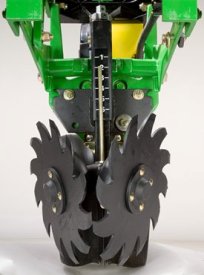
Screw-adjust, unit-mounted row cleaner
The screw-adjust, unit-mounted row cleaner is mounted directly to the face plate of the row-unit, placing the ground engaging components just in front of the row-unit opener blades and depth gauge wheels. This close proximity allows the gauge wheels to control the depth of the row cleaner as well as the row-unit. This compact design also allows greater compatibility with fertilizer openers and other planter attachments.
SharkTooth® wheels are standard equipment on the unit-mounted row cleaner. The swept-tooth design of the wheel provides a clear path for the row-unit openers while resisting residue buildup on the wheel. The screw adjustment knob is accessible through the top of the parallel arms, providing convenient access for adjustments. The row cleaner can be adjusted in 1.6-mm (1/16-in.) increments, providing plenty of flexibility to meet the needs of changing conditions.
Floating row cleaner with unit-mounted coulter
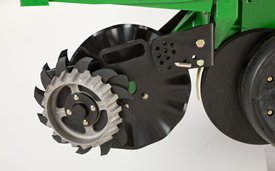
Floating row cleaner with unit-mounted coulter
The floating row cleaner allows a row cleaner to be used in conjunction with a unit-mounted coulter. This combination is often desired in heavy residue loads and reduced tillage planting conditions. The row cleaner provides a clear path for the row-unit, while the unit-mounted coulter helps penetrate tough soil conditions.
Accommodating the unit-mounted coulter means the residue wheels are farther forward from the row-unit face plate than in the case of the screw-adjust row cleaner. To maintain performance, this row cleaner has the capability to float above a defined minimum depth.
Standard depth-gauging bands on the wheels allow the row cleaner wheels to float independently of the row-unit openers, allowing both to perform in varying terrain. The unit may also be set in a fixed position by simply pinning through the bracket if desired. This row cleaner also features SharkTooth wheels as standard equipment.
The floating row cleaner and unit-mounted coulters are available on many planters as factory-installed equipment.
NOTE: Screw-adjust row cleaners are not compatible with MaxEmerge™ 5e row-units with long parallel arms.
NOTE: DB models have the option for either unit-mounted coulter, screw-adjust row cleaners, or pneumatic row cleaners (only compatible with MaxEmerge 5e or equipped ExactEmerge™ models). The DB60T is only available with a less row cleaner option.
SharkTooth is a trademark of Yetter Manufacturing, Inc.
MaxEmerge 5 bundles the best of MaxEmerge XP and Pro-Series™ XP row-units to give you a unique planter solution. With more options and configurations, you’ll get difference-making versatility that easily adapts to your ag management plan.
It starts with optimal seed population that drives yield potential. An improved double eliminated helps achieve your desired population with a ride range of crop sizes. Improved side-hill performance of up to ¼ degree ensures you receive the full value of each seed when planting on terraces or rolling terrain. The vacuum air source from the Central Commodity System (CCS™) tank in the meter provides a debris-free environment for increased meter efficiency.
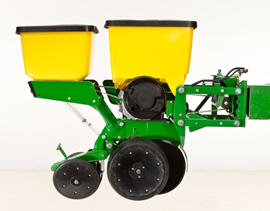
MaxEmerge 5 with 56-L (1.6-bu) hopper plus insecticide
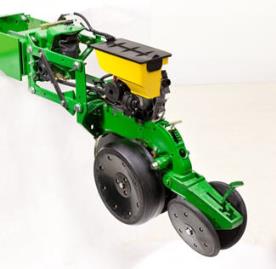
MaxEmerge 5 with mini-hopper on CCS™ machines only
The MaxEmerge family of row-units have never seen a more versatile and efficient design until the MaxEmerge 5. The 5-family row-units improve productivity, increase uptime and lower the cost of ownership like never before.
The MaxEmerge 5 row-unit was designed for improved performance and serviceability.

Easily access the meter
Serviceability and changing crops have always been a focus of downtime and potential seed loss. The MaxEmerge 5 meter (shown on the right) is accessible without having to remove the box. The design allows large hoppers to be cleaned out the same as mini-hoppers, simply by opening the meter dome and catching the seed as it falls out.
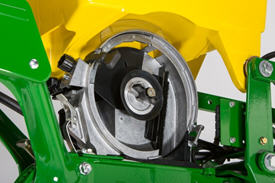
MaxEmerge 5 vacuum seed meter
The vacuum meter system gently pulls and holds individual seeds to the holes of the seed disk for population control and spacing accuracy, equaling better crop stands and profit. Vacuum seed meters can plant a wide variety of crops and seed types by simply changing seed disks and adjusting vacuum level. Vacuum seed meters are available for planters with MaxEmerge 5 row-units.
Additional features of the vacuum seed meter include:
- One moving component (the seed metering disk) for minimum maintenance requirements
- Meter located at each row-unit for accurate seed delivery
- Good hopper seed flow characteristics for longer operating time per hopper fill
- Low airflow in meter so seed treatments are not removed
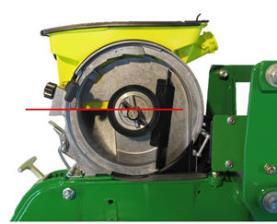
MaxEmerge 5 seed pool
The MaxEmerge 5 meter shape has also been redesigned for better seed flow. The mini-hopper design allows the planter to successfully operate on side hills up to 14 degrees.
Vacuum meter hub and latching handle
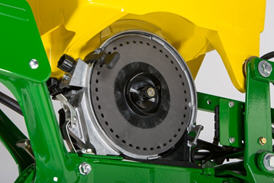
MaxEmerge 5 vacuum meter with disk
Both the MaxEmerge 5 vacuum meters are equipped with a heavy-duty hub spring and disk latching handle. The spring ensures the seed disk stays properly positioned when operating flat-style seed disks and higher vacuum levels. Proper seed disk positioning means repeatable seed singulation, time after time. The disk-latching handle is designed for easy operation and effortless seed disk changeover. The hub is also machined to tight tolerances to further ensure alignment of metering components.
Vacuum meter seed disks
The ProMax 40 Flat Disk is a flat-disk planting solution field-proven to work since 1991.
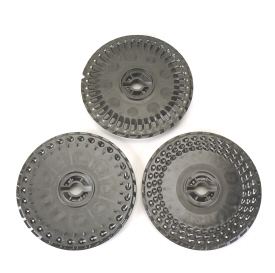
Flat-style and cell seed disks shown
The unique cell disk design allows planting a variety of seed sizes without any additional parts or individual meter adjustments. Another advantage of cell-type seed disks is the lower vacuum requirement compared to flat-style seed disks. Lower vacuum levels mean less hydraulic demand from the tractor. Most planting conditions call for a flat disk, if you are limited in hydraulic capacity, cell disks are recommended.
Operating characteristics of vacuum seed meter
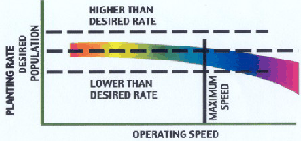
Operating speed with seed tube technology
The vacuum seed meter can operate at faster planting speeds than mechanical meters. However, planting accuracy will be influenced by seedbed conditions and the operating characteristics of the seed meter. Rough seedbeds and fast planting speeds (above 8.9 km/h [5.5 mph]) typically deteriorate seed placement accuracies when using seed tube technology.
The chart illustrates the effect operating speed has on population when using the vacuum meter. The operating band (color area) illustrates how the vacuum meter performs in relation to the desired population (indicated by horizontal line). The width of the band is due to various sizes and shapes of seeds and planting rate variations.
When operating on slopes above 15 degrees, increased or decreased population may result. To minimize this effect, reduce speed and consider using a flat style seed disk with increased vacuum level.
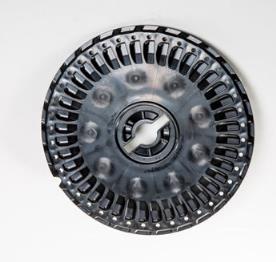
ProMax 40 Flat Disc
The design of the ProMax 40 Flat Disk position allows seed to be released from the optimum position above the seed tube. The flush-face seed tube allows the seed to drop uninterrupted through the tube.
The ProMax 40 Flat Disk utilizes flat holes and a higher vacuum level to ensure every hole is populated with a seed. A double eliminator gently removes multiple seeds at each hole for precise population control. A knockout wheel makes certain that each hole is clear of any debris after the seed is released from the disk.
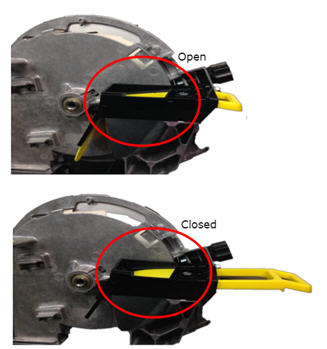
Hopper shutoff

Also, to help with meter access of 56-L and 106-L (1.6-bu and 3-bu) hoppers the hopper shutoff feature was added. With the shutoff engaged, the meter cover can be opened without first having to remove all the seeds from the hopper. Lever down, the seed flow is on, lever horizontal and the seed flow is off.
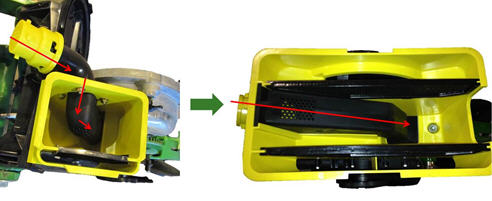
MaxEmerge 5 mini-hopper

There are significant changes to the MaxEmerge 5 mini-hopper. One update is the straight feed from the CCS hose to the mini-hopper to ensure a continuous free flow of seeds. This design change reduces the potential for plugging issues with larger seed size and the use of seed treatments. By drawing air from the CCS tank, the vacuum source is cleaner, preventing meter debris buildup.
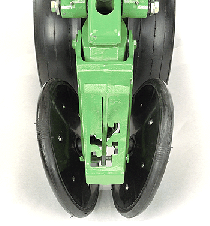
Rubber tire closing system
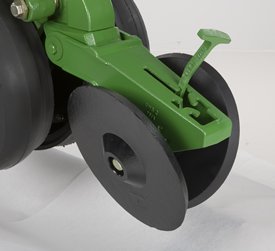
Cast wheel closing system
Rubber tire closing systems are used for most conventional, minimum-till, and no-till planting conditions. The spacing between the wheels is adjustable so the closing system can meet the needs of those who want to plant small seeds at shallow depths.
The wheels can also be staggered fore and aft to enhance residue flow. Four levels of spring force are available and are easily set with the integrated T-handle adjustment. A lower force spring can be obtained from parts, if a lower amount of force is required.
Additional closing wheel options include:
- Cast closing wheels for tough-to-close conditions
- Disk closing, for shallow planting depths
- Closing wheel frame less wheels for growers desiring to use aftermarket closing wheels
Double eliminator
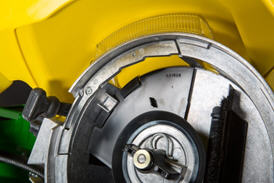
Flat seed disc and double eliminator
For difficult to singulate seeds, a flat seed disk and double eliminator is a viable alternative to traditional cell-type seed disks. By design, a flat seed disk requires higher levels of vacuum than a cell-type disk because there is no pocket or cell to hold the seed. The higher vacuum level will pull more than one seed to the holes in the seed disk. The double eliminator is set to cover a portion of the hole in the seed disk and is the mechanism to knock multiple seeds away as the disk rotates.
Double eliminators are required with flat-type seed disks only and should not be used with cell-type seed disks. The knockout wheel is also recommended in conjunction with the double eliminator and flat seed disk to ensure seed is ejected from the disk.
Flat and celled type seed metering disks are available to allow planting a wide variety of seed types.
- Corn (field, popcorn, or sweet corn)
- Soybeans
- Cotton
- Sorghum
- Sugar beets
- Sunflowers
- Edible beans/peas
- Peanuts
- Melons, squash, cucumbers
Mini-hopper row-units, which are used only with the CCS, are compatible only with crops that the CCS is approved to plant.
- Corn
- Popcorn
- Sweet corn
- Soybeans
- Sunflowers
- Sorghum
- Cotton
NOTE: Due to small seed size and low planting populations, sugar beets can be planted with mini-hopper style meters by adding hopper extensions and not using the CCS tank. These hopper extensions can also be used for planting test plots.
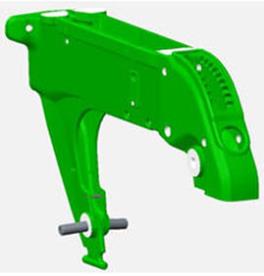
Ductile iron-cast shank
Ductile iron casting is a unique high-tech process that produces a single-piece row-unit shank this enables alignment from the seed trench to the closing wheel.
The row-unit head is also designed using the ductile iron-casting process. The row-unit head provides the mating joints between the row-unit parallel arms and the row-unit shank. It is also the upper attaching point for the seed meter and seed hopper.
Ductile iron casting of the row-unit shank and head assembly provides a row-unit that is 25 percent stronger than other competitive welded row-units.
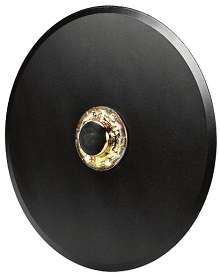
Tru-Vee opener blade
One of the trademark capabilities of John Deere planters has always been the ability of the Tru-Vee openers to provide an ideal seed furrow.
The thickness of the Tru-Vee opener blade is 3.5 mm (0.14 in.) this blade thickness will provide extended wear life.
The MaxEmerge 5 row-unit also provides better Tru-Vee opener bearings for longer life. The double-row ball bearing provides up to three times the wear life as the single-row bearing.
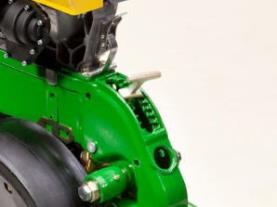
Depth adjustment T-handle

John Deere planters provide consistent seed depth control in all field conditions. Depth control is a function of the Tru-Vee openers, the downforce system, and the gauge wheel assembly.
The gauge wheel itself is made of durable nylon composition with a concave profile. This profile gently firms the sides of the seed furrow, ensuring a well-defined trench. The shape reduces rocks and residue being picked up and thrown onto the drive chains and row-units, and helps to prevent rooster tailing of soil.
The bolt-through design utilizes an open bearing in the gauge wheel that allows an attaching bolt to pass through the wheel to the threaded hole in the gauge wheel arm. This simple bolt-through design provides for a positive attachment of the gauge wheel to the gauge wheel arm and allows quick removal of the gauge wheel for service.
Adjustability of the row-unit is critical to good performance. More available downforce options than any row unit in the industry
- Adjustable heavy-duty downforce, four settings, 0 kg (0 lb), 57 kg (125 lb), 113 kg (250 lb), and 181 kg (400 lb) of downforce
- Pneumatic downforce, infinitely variable from 0 to 181 kg (0 to 400 lb) of downforce
- Active pneumatic downforce adjusts automatically for changing ground conditions from 0 to 181 kg (0 to 400 lb) of downforce
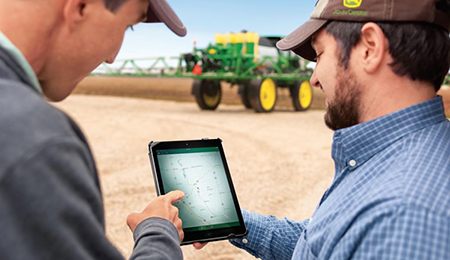
Connected Support technology
When you buy John Deere equipment, you expect reliability. You also know that problems can happen, and a product is only as good as the support behind it. That’s why John Deere equipment is prepared with technology that senses potential issues and can alert you and your dealer promptly—in the cab or anywhere you are.
John Deere Connected Support is a revolutionary change to support that leverages technology and the connectivity of JDLink™ telematics to prevent downtime and resolve problems faster. These tools decrease downtime by an average of 20 percent, enabling faster responses to unexpected problems and reducing technician trips to your machine. For some issues, unplanned downtime can even be prevented altogether through prediction of the issue.
With your permission, John Deere Connected Support:
- Keeps you running by monitoring machine health and promptly alerting you and your dealer of issues
- Saves time by remotely viewing in-cab displays, reducing trips to the machine
- Reduces or even eliminates technician trips to a machine through remote diagnostic and remote software reprogramming capabilities
- Connects experts with the information needed to respond to downtime faster and prevent it altogether
With more than a decade of experience leveraging connectivity to solve problems, no one else has the experience, tools, and knowledge to keep you running as John Deere and your John Deere dealer can. Connected Support is an in-base feature on all John Deere products with factory- or field-installed JDLink.
Granular fertilizer hopper and transmission
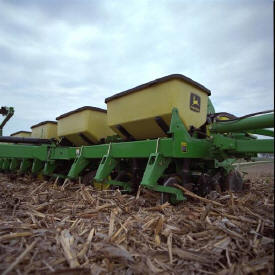
Granular fertilizer hopper and opener
Granular fertilizer is available for 1755, 1775, and 1785 Planters. Fertilizer hoppers/tanks and selected other equipment may not be installed to facilitate shipping. Fertilizer attachments place fertilizer only on 76.2-cm, 91.4-cm, or 96.5-cm (30-in., 36-in., or 38-in.) spacings. Some planter frame and row spacing combinations result in the opener offset 10.1 cm to 15.2 cm (4 in. to 6 in.) from the centerline of the Tru-Vee opener.
Hoppers hold approximately 249.5 kg (550 lb) of fertilizer for longer operating time between fill-ups. One hopper feeds two rows. Hopper lids provide a large opening for fast filling with less spillage. Hoppers pivot for easy dumping and cleaning.
The transmission (two on 1775) has 24 sprocket combinations in consistent 6 percent increments to allow operators to apply fertilizer at the desired application rate. Depending on which auger is selected, a wide range of fertilizer rates can applied from 52.7 kg/ha (47 lb/acre) to 803.7 kg/ha (717 lb/acre). It requires openers or a surface application bracket.
Augers for granular fertilizer system
Low-, regular-, or high-rate feed augers are required to complete the granular fertilizer system. Augers move fertilizer from the fertilizer boxes to the opener. Regular- or high-rate augers are matched with the opener style selected and are available as a factory-installed option or as an attachment for field conversion. Low-rate augers are only available as an attachment for field conversion.
For 76.2-cm (30-in.) rows, the approximate rate of application is as follows:
-
Low-rate augers – 52.7-139 kg/ha (47-124 lb/acre) -
Regular-rate augers – 105.4-533.5 kg/ha (94-476 lb/acre) -
High-rate augers – 183.8-803.7 kg/ha (164-717 lb/acre)
For 96.5-cm (38-in.) rows, the approximate rate of application is as follows:
-
Low-rate augers – 41.5-208.5 kg/ha (37-186 lb/acre) -
Regular-rate augers – 82.9-418.1 kg/ha (74-373 lb/acre) -
High-rate augers – 124.4-626.6 kg/ha (111-559 lb/acre)
NOTE: Weight metered may vary from that indicated because the fertilizer attachment will meter by volume not by weight and because of differences in fertilizer density.
1755 and 1785 granular fertilizer openers
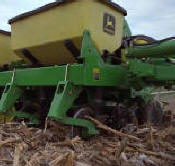
Granular fertilizer opener
Frame-mounted, double-disk openers and frame-mounted, single-disk openers for granular fertilizer are available on the 1755 and 1785 Planters. The frame-mounted, single-disk opener is available with a regular spout or cast spout. Fertilizer openers place the granular fertilizer into the soil for maximum plant uptake and are adjustable. Single-disk fertilizer openers are required for no-till, but are also suitable for conventional and reduced tillage. Double-disk fertilizer openers should only be used in conventional and reduced tillage conditions.
-
Single- and double-disk openers are compatible with frame-mounted coulters. -
Single-disk opener with cast spout is recommended for all soil conditions because it keeps soil from flowing into the furrow before fertilizer is delivered. -
The gauge wheel on single-disk openers will help gauge fertilizer application depth and minimize soil disruption. -
On 1755 8Row30 Planters, due to frame limitations, the granular fertilizer systems with single-disk openers can place fertilizer no closer than 12.7 cm to 15.2 cm (5 in. to 6 in.) to the seed furrow on rows 4 and 5.
1770 granular fertilizer openers
Frame-mounted, single-disk fertilizer openers with cast spout are utilized on the 1775 12Row30 Planter. These openers are ideal for both conventional and no-till. The openers are adjustable to place the fertilizer in the soil next to the seed furrow for ideal nutrient placement and maximum plant uptake. A single gauge wheel allows the opener to follow the contour of the ground for ideal fertilizer depth placement. Single-disk fertilizer openers are compatible with frame-mounted coulters.

1765NT tire contact drive system
The tire contact drive for mechanical seed transmissions is a great fit for the mid-to-large planter operator concerned with quick transport capabilities, lower maintenance, and positive seed meter drives. The tire contact drive system is a simple, reliable, and efficient way to power seed transmission and meters.
The tire contact system drives the seed transmission mounted above the inner planter ground drive tire. A turf tire engages the ground drive tire when the planter is lowered, automatically turning the seed transmission and seed meters. Automatic drive disconnect occurs when the planter is raised and the turf tire separates from the ground-engaging tire. The system eliminates clutches, countershafts, and manual transport disconnects needed on direct ground drive systems. Drive chains and sprockets are moved up and out of the soil and residue zone for excellent reliability.
Tire contact drive systems are base equipment on the 1745, 1765, 1765NT, 1775 12-Row, and 1785 Planters. Contact between the ground-engaging tire and seed transmission tire is positive. On all models mentioned, a spring set applies downforce of the turf tire assembly onto the ground-engaging tire. System slippage is also minimized because the planter drive tires track in the tractor tire tracks. Frame designs differ (such as tire width) and the following different downforce requirements exist:
-
1765 8-Row drives have 207.3 kg (457 lb) of downforce. -
1765 and 1775 12-Row drives have 254 kg (560 lb) of downforce.
The 1745 model uses one front-mounted seed transmission, and if the planter is equipped with fertilizer, another front-mounted transmission is utilized. The 1765 model uses one rear-mounted seed transmission. However, if the planter also has the fertilizer option, there is another rear-mounted transmission for the fertilizer drive. The 1785 Rigid Planters utilize one front-mounted seed transmission, and if the planter is equipped with the liquid fertilizer option, another front-mounted transmission is utilized. The 1775 12-Row Planter utilizes two rear-mounted seed transmissions. Another rear-mounted transmission is used if the planter has the fertilizer option.
| Rows and Row Spacing - Number of rows | 12 |
|---|---|
| Frame - Fold configuration | Front-fold |
| Frame - Fold-and-go from tractor cab | Manual wing lock pin |
| Frame - Flexibility | 2-section flex frame, 20 degrees up, 30 degrees down |
| Hitch - Base | Two point hitch for Cat.II or Cat.III with Quick Coupler only |
| Hitch - Optional | NA |
| Hitch - Rear hitch | NA |
| Lift System - Type | Wheel module |
| Lift System - Number of cylinders | 8 |
| Tires - Base | 9.5L x 15 in. F1 load range D |
| Tires - Optional | NA |
| Tires - Quantity | 8 |
| Row Units - Depth gauging | (2) semi-pneumatic wheels - 4 1/2 x 16 in. |
| Row Units - Adjustment | T-handle, 1/4 to 4 depth in 1/4 increments in. |
| Row Units - Walking wheels | Optional |
| Seed Meters - Base | Vacuum |
| Seed Meters - Optional | Plateless |
| Seed Meters - Finger pickup | Optional |
| Drive System - Base | Tire contact |
| Drive System - Optional | 1 or 2 motor hydraulic variable rate drive |
| Drive System - Number of drive wheels | 1 for seed transmission and 1 for dry fertilizer |
| Drive System - Drive wheel disconnect | Automatic |
| Drive System - Counter shaft | 7/8 hex in. |
| Drive System - Drill shaft | 7/8 hex in. |
| Drive System - Seed transmission | Tire contact |
| Drive System - Transmission combinations | 50 sprocket combinations |
| Markers - Type | Tri-fold |
| Markers - Shear bolt protection | Base equipment |
| Markers - Less marker option | Optional |
| Herbicide and Insecticide - Insecticide only hopper | Optional -- capacity, 70 lb |
| Herbicide and Insecticide - Herbicide only hopper | NA |
| Herbicide and Insecticide - Insecticide and herbicide hopper | Optional -- split hopper, each side - 35 lb |
| Liquid Insecticide System - System available | NA |
| Liquid Insecticide System - Tank capacity | NA |
| Tillage Attachments - Unit-mounted coulter | Optional |
| Tillage Attachments - Frame-mounted coulter | Optional |
| Tillage Attachments - Bubble blade | Optional |
| Tillage Attachments - Row tillage support hanger | Optional |
| Tillage Attachments - V-wing bed sweeps | NA |
| Tillage Attachments - Row cleaner - unit-mounted DD fert. opener | Optional |
| Fertilizer - Onboard / towed / tractor tanks | NA |
| Fertilizer - Tank capacity | NA |
| Fertilizer - Fixed-rate application | NA |
| Fertilizer - Variable-rate application | NA |
| Fertilizer - Pump type | NA |
| Fertilizer - Pump rate | NA |
| Fertilizer - Flow divider distribution system | NA |
| Fertilizer - Pressure manifold distribution system | NA |
| Dimensions - Transport width (with markers) | 15, 2 ft, in. |
| Dimensions - Transport length | 29, 6 ft, in. |
| Dimensions - Transport weight | 11900 lb |
| Ag Management Solutions - Map-based seeding | Optional |
| Ag Management Solutions - Field documentation | Optional |
| Ag Management Solutions - Parallel tracking | Optional |
| Additional Information - Recommended tractor horsepower | 120 - less fertilizer, 140 - w/fertilizer hp |
| Additional Information - Warranty length | 1 year |
| Row Units - Scrapers, opener blades | Plastic rotary NA Steel straight blade Optional Heavy-duty Optional Optional |
| Rows and Row Spacing - Row spacing | 30 in. 76 cm |
| Additional Information - Recommended tractor hydraulics | 15514 maximum kPa 2250 maximum psi |
| Dimensions - Transport height | 3.4 m 11.25 ft, in. |
| Row Units - Row unit down force | Non-adjustable (4 springs) 180 lb Adjustable heavy-duty 4 settings: 0, 125, 250, 400 lb Pneumatic Base, Infinitely adjustable to 400 lb Base equipment |
| Row Units - Seed tube sensors | Optional Standard Base |
| Frame - Frame tube size | 17.8 x 17.8 cm 7 x 7 in. |
| Key Specs - Row unit seed hoppers | |
| Row Units - Row unit seed hoppers | Capacity 0.06 or 0.11 m3 1.6 or 3.0 bu Material 1.6 - polyethylene or 3.0 - roto-molded plastic bu |
| Markers - Marker disk | Base Notched w/depth gauging band - 16 in. Optional Marker arm gauge wheel |
| Closing System - Rubber tire closing system | Wheel (2) rubber tires w/nylon wheel - 1 x 12 in. Position In-line or staggered Adjustment T-handle Down force 5 position 0-145 lb Alignment Adjustable side to side Base |
| Key Specs - Seed Meters | |
| Markers - Control | Base Independent of lift Optional Connected to lift Independent of lift or connected to lift |
| Closing System - Cast iron closing system | Wheel (2) cast iron wheel - 1 x 12 in. Position In-line or staggered Adjustment T-handle Optional |
| Fertilizer - Fertilizer opener type | Frame-mounted NA Unit-mounted NA |
| Seed Meters - Central Commodity System | Seed capacity NA NA |
| Fertilizer - Dry fertilizer | Number of hoppers 6 Hopper capacity 550 lb Base equipment |



